
Today, being high tech means delivering the newest and freshest gear ALL the time. One person, we can definitely say is all high tech, is the American Producer, DJ, Sound Engineer, Adam Freemer(AF). Freemer has been producing/remixing/DJing for nearly 15 years, with billboard hits on Twisted Records(U.S.) and TKC Music. He has continued support from underground DJs such as Danny Tenaglia, Victor Calderone, DJ Vibe, John Digweed, Danny Howells and Tom “Superchumbo” Stephan to name just a few. Adam has worked on and engineered some of the world’s best sounding nightclub systems. Freemer’s involvement in club audio goes further than just a system. His philosophy on sound is defined like an art form. As technology expands, his ability to make any venue an enjoyable and memorable experience for any club-goer remains untouchable. Adam shares his philosophy on sound, his involvement with “G” Philadelphia and his new label, MECHA RECORDINGS in this exclusive interview.
VM: Adam, like most of us growing up in the golden era of the 80’s tell us a little about growing up. How do you define your best childhood memories?
Adam: Yes!, the 80’s was a great time!! I was a huge video game and computer geek growing up. Atari was my tech of choice and hmm, let me see, I started with an Atari 2600 game console, and went on to have an Atari 800, 800XL and finally a 520ST with a whole 2 megs of RAM (upgraded of course)! It’s amazing thinking back how far computers have come along. Interestingly enough, my 520ST was the first computer to have built in MIDI ports/support (circa 1985) and the 520ST was what peaked my curiosity about electronic music, synthesis, music production, etc. I got my first MIDI editor on my 520ST and started playing around with the primitive synthesizer software they had back then, and picked up my first keyboard, a Casio CZ-230S and that kept me occupied for hours on end.
One of my best memories of that era was my best friend, who was also named Adam, whom was also an Atari computer nerd like me. We spent a lot of time together growing up and playing around with computer stuff, video games, etc. The memories became especially important when a few years ago I found out, after losing touch with Adam for several years, he passed away.
Besides playing on the computer, I really remember a lot of classic 80’s movies with which I identify with. Ferris Bueller, War Games, Back To The Future, etc. It definitely was simpler times back then, if I dare say, a much more “fun” time to live in.
VM: You have an Engineering and Pro Sound background, which has certainly helped in your career. An example of your sound system and video engineering capabilities is the system at “G” in Philadelphia. What do you have going on over there?
Adam: “G“ was a project that literally fell into my lap after a manufacturer rep friend of mine in the industry, got this job passed to him, and felt I (and my company) would be the best to take on the project. After spending a great deal of time with the owner of the club, I helped guide him and educate him on the sound and video for this new venue. The owner had his vision, and I just kind of ran with it and came up with the design for the audio and visual systems in the club. It was very challenging and unlike anything I’ve ever done before, as G is a real hodge podge of analog, digital, hi-fi and multi-zone audio technology, all wrapped up in one project.

The owner wanted to be able to take his venue, split it into different sections and have multiple dj booths and sources that could be reconfigured on the fly in a simple manner. Also, the main dance area was required to have very high fidelity sound, which is typically a contradiction with digital matrix audio routing designs. Without getting into the nitty gritty (here’s a link to the actual details of the design: HIGHTECH HOTSPOT ARTICLE), in the end, I pulled from what I knew, which was combining traditional analog nightclub technology that us “big nyc system” club types like to see in a club, with modern digital technology to take care of the technological challenges. It worked out well, and G is the hottest lounge in Philadelphia right now. I’m especially proud of the fidelity there, which to me, is so important. You can listen to a dance record, or even something like a jazz or 80’s record, and it sounds great and doesn’t hurt your ears, even over an extended listening period. To me, that’s at the core of my philosophy based on my years as a clubber, if it doesn’t hurt your ears, its good sound.
VM: What philosophies do you believe in when it comes to sound?
Adam: Well I should read ahead a bit I guess?! However, to continue where I left off from the last question, the core of my philosophy is being able to listen to a system for hours on end and not be fatigued. It was always a simple concept to me. If the sound is hurting your ears, your ears get fatigued. If your ears get fatigued, you physically feel fatigued. When you feel fatigued, you leave the club. It never made sense to have a system so obnoxiously loud where the patron would want to leave.
I also believe in a statement drilled into my head during college “KISS”, or KEEP IT SIMPLE, STUPID! If you don’t have to make something complicated, don’t. Sometimes the simplest solution is the best. As much as I love analog technology, sometimes digital makes sense as well, when you can reduce devices in a signal chain. Less devices means lower signal loss and less chances of a component failing.
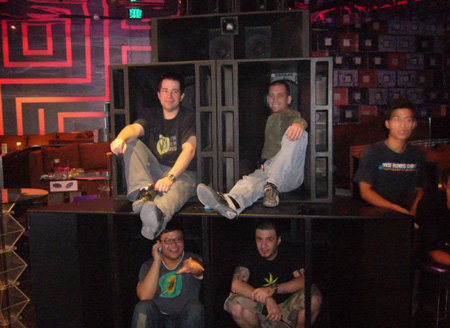 Shorty (Craig Barnabeu) my friends from China, Dave K and Eddie Nesh, and myself. It was during the end of a month long installation of the sound system at G-Spot in Shanghai, an amazing experience.
Shorty (Craig Barnabeu) my friends from China, Dave K and Eddie Nesh, and myself. It was during the end of a month long installation of the sound system at G-Spot in Shanghai, an amazing experience.
I could not talk about my pro-sound background without mentioning Shorty (Systems By Shorty, Craig Barnabeu) as I learned a great deal from him and admire his work ethics and amazing knowledge of nightclub audio. Shorty has a lot of admiration for the famed sound engineer Richard Long, whom I admire as well. Being that club sound goes so hand-in-hand with the music that plays through the speakers, I’ve always felt that it all connects and knowing my way around the studio as well as the systems in a club, can only be helpful.
VM: Mecha Recordings, is your new record label. We notice you are starting with a talented and diversified group.
1) Toby Dreher – “Sommertag im Neissetal EP” ……brilliant artist.
2) Exit 59 – “Disco” Remixes by: D-Formation, Toby Dreher, Roman S and Costanzo & Vukas….getting A LOT of play time on the PULSE in NYC.
3) Syntec & Quick – “Small Room EP” ……an amazing minimal tech duo.

Tell us a little about Mecha Recordings, the direction and who can we expect on the fourth release……
Adam: “Mecha” was a name I had just floating around for a long time as a possible label name. Originally the idea popped into my head after watching the Steven Spielberg movie: A.I. which moved me quite a bit (I’m a sci-fi junkie). Mecha was a term thrown around in the movie meaning mechanical, not of the Earth, but based on living things. To me it was an interesting term, and I’ve always produced music which I felt was partly organic in nature, having drums, traditional instrument sounds, etc, but combined with synthetic sounds, from synthesizers, etc. So the phrase “Mecha, not of this Earth” came together as the statement for the label. The Mecha symbol is Japanese for Earth or soil. So Mecha below, Earth above, not of this Earth. A little too far off on a tangent here, but I just thought I’d explain my thoughts.
The label was born when one of my best friends, Sergio Caetano and I sat down and really brainstormed the whole label concept and what we envisioned. While in the brainstorming phase, my long time friend, Mike Constantini came into the picture because of his amazing knack to find great artists and music. All 3 of us are very close in style musically, so with Mike on board as A&R, the stage seemed set to move forward. The three of us were “molded” musically by our long nights listening to Danny Tenaglia in the 90’s/early 00’s era, and one thing we all agreed on was to not limit the label to any one style. All of us acknowledged that there are so many labels these days and the last thing we wanted was another label just releasing random material of one genre. Our concept was to release music that covered all the genres that we liked. Whether it be minimal, progressive, techy or even more commercial, we wanted to create a label that could release music with no boundaries. And to take it further, have releases that reflected many different genres, all in one package. Our first few release we feel really reflect that, especially with Disco, a commercial track by any measure, but with remixes covering a whole gamut of sounds and styles.
As far as our fourth release, that’s still under wraps at this point. We have about 6-8 releases scheduled, but we’re just trying to determine the best release order. One thing we want to do is keep people anticipating the next release by mixing it up. Our first release, Toby Dreher’s EP is a definite minimal techno styled sound. Our second a more commercial / mixed sound, etc, etc. Upcoming after release 3 is an amazing deep house original vocal track that will be featuring soon to be determined remixes as well as a single I’m working on with Alan T that will be co-released with Sessions recordings out of Japan, the in-house label/promotion company that works with Womb, Tokyo.
VM: You have been based in Philadelphia, will this be the base for Mecha with international artists?
Adam: We consider Mecha an American based label with Sergio and I currently residing in Philadelphia. However, with Mike located in South Korea, it definitely gives Mecha an International flavor. Overall the 3 of us consider Mecha an American label with what we would consider to be a global sound.
VM: You seem to be 50/50 with production and DJing at the moment, do you see this changing soon? If so why?
Adam: Well, that has definitely changed! Now it’s 33% DJ’ing, 33% production and 33% label business! haa! When we started talking about the label, I knew part of my duties would be working the artists and remixers on developing tracks to what we were looking for, mastering, helping with production, etc. Also I’ve taken on quite a bit of the technical aspects from developing the website, myspace page, etc, as well. It’s definitely very time consuming.
However, from the standpoint of what I do best or like to do, I really like dj’ing and making music / production equally. And in this day and age of your music being your promotional vehicle, I feel it’s important to keep your production release schedule as consistent as possible.
VM: You have been playing around the world, met a lot of talented producers and djs. How do you see America ‘s role in dance music. Past to present.
Adam: I’ve always believed that America, specifically New York, was the center of dance, or more specifically, house music. The point is, New York / America is the roots from which dance music has sprung, but at this point, with the internet and instant access to anything and anyone, the scene has truly globalized. One downfall of the U.S. is its quest for commercialism and greed. MTV and the push of a type of brandable and marketable music (Hip Hop, Pop, whatever you want to call it) has destroyed a great deal of dance culture in the U.S.. We never had a culture quite as strong as the European dance scene, but the little we did have, seems to have withered into a poor state.
Over the last 10 years I’ve watched an amazing underground scene in New York give birth to the current commercial scene where it seems most clubbers go out to do their naughty little things and just be out. It’s so much less about the music it seems these days, unfortunately. I think the core is still there and there are great clubs such as Cielo, Love, etc, and many say it all works in cycles. I hope in a few years it all comes around again, who knows!
Visao Media would like to thank Sergio Caetano, Mike Constantini and especially Adam Freemer. We can’t wait to hear what comes from Mecha Recordings!!
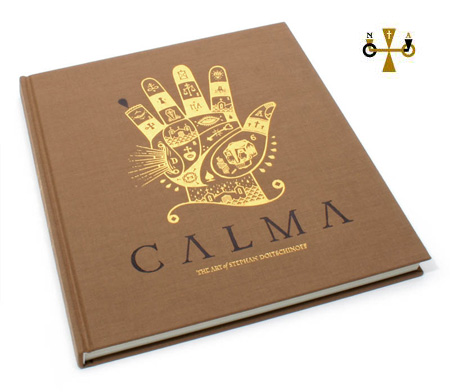
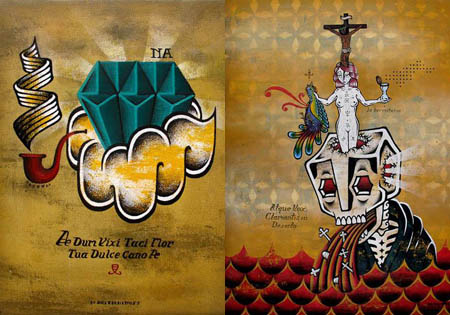
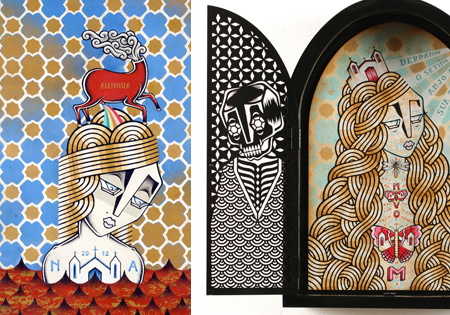
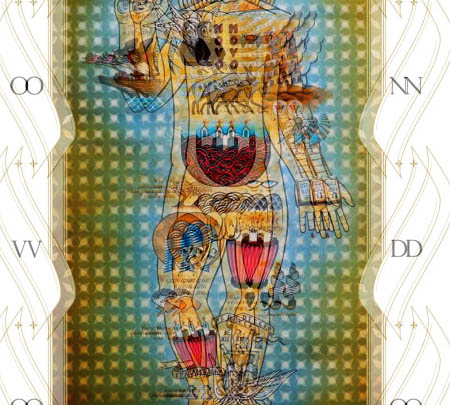







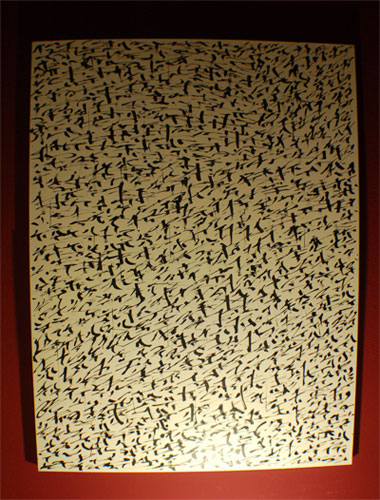
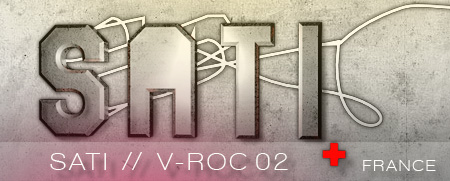
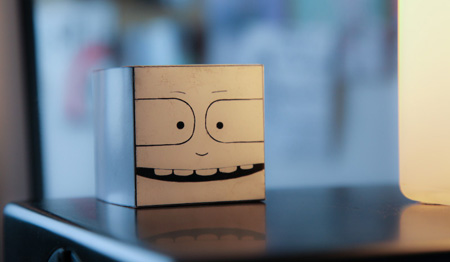





 Shorty (Craig Barnabeu) my friends from China, Dave K and Eddie Nesh, and myself. It was during the end of a month long installation of the sound system at G-Spot in Shanghai, an amazing experience.
Shorty (Craig Barnabeu) my friends from China, Dave K and Eddie Nesh, and myself. It was during the end of a month long installation of the sound system at G-Spot in Shanghai, an amazing experience.